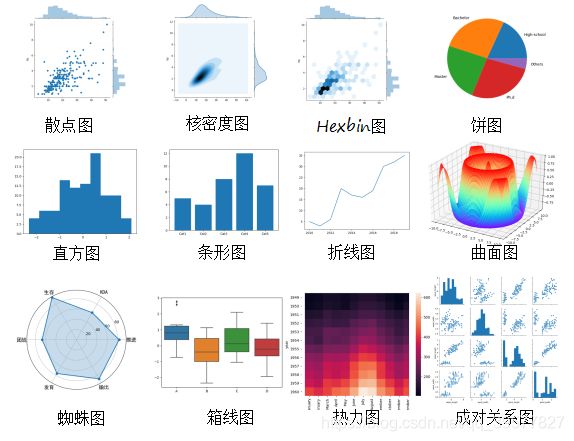python的可视化库(seaborn和matplotlib)
今天我将和大家一起入门这十种简单图的绘制

1.散点图
import numpy as np
import pandas as pd
import matplotlib.pyplot as plt
import seaborn as sns
N = 1000
x = np.random.randn(N)
y = np.random.randn(N)
plt.scatter(x, y,marker='x')
plt.show()
df = pd.DataFrame({'x': x, 'y': y})
sns.jointplot(x="x", y="y", data=df, kind='scatter');
plt.show()


2.折线图
import pandas as pd
import matplotlib.pyplot as plt
import seaborn as sns
x = [2010, 2011, 2012, 2013, 2014, 2015, 2016, 2017, 2018, 2019]
y = [5, 3, 6, 20, 17, 16, 19, 30, 32, 35]
plt.plot(x, y)
plt.show()
df = pd.DataFrame({'x': x, 'y': y})
sns.lineplot(x="x", y="y", data=df)
plt.show()
3.直方图
import numpy as np
import pandas as pd
import matplotlib.pyplot as plt
import seaborn as sns
a = np.random.randn(100)
s = pd.Series(a)
plt.hist(s,bins=10)
plt.show()
sns.distplot(s, kde=False)
plt.show()
sns.distplot(s, kde=True)
plt.show()
4.条形图
import matplotlib.pyplot as plt
import seaborn as sns
x = ['Cat1', 'Cat2', 'Cat3', 'Cat4', 'Cat5']
y = [5, 4, 8, 12, 7]
plt.bar(x, y)
plt.show()
sns.barplot(x, y)
plt.show()
5.箱线图
data=np.random.normal(size=(10,4))
lables = ['A','B','C','D']
plt.boxplot(data,labels=lables)
plt.show()
df = pd.DataFrame(data, columns=lables)
sns.boxplot(data=df)
plt.show()
6.饼图
import matplotlib.pyplot as plt
nums = [25, 37, 33, 37, 6]
labels = ['High-school','Bachelor','Master','Ph.d', 'Others']
plt.pie(x = nums, labels=labels)
plt.show()
7.热力图
import matplotlib.pyplot as plt
import seaborn as sns
flights = sns.load_dataset("flights")
data=flights.pivot('year','month','passengers')
sns.heatmap(data)
plt.show()
8.蜘蛛图
import numpy as np
import matplotlib.pyplot as plt
import seaborn as sns
from matplotlib.font_manager import FontProperties
labels=np.array([u"推进","KDA",u"生存",u"团战",u"发育",u"输出"])
stats=[83, 61, 95, 67, 76, 88]
angles=np.linspace(0, 2*np.pi, len(labels), endpoint=False)
stats=np.concatenate((stats,[stats[0]]))
angles=np.concatenate((angles,[angles[0]]))
fig = plt.figure()
ax = fig.add_subplot(111, polar=True)
ax.plot(angles, stats, 'o-', linewidth=2)
ax.fill(angles, stats, alpha=0.25)
font = FontProperties(fname=r"C:\Windows\Fonts\simhei.ttf", size=14)
ax.set_thetagrids(angles * 180/np.pi, labels, FontProperties=font)
plt.show()
9.二元变量分布
import matplotlib.pyplot as plt
import seaborn as sns
tips = sns.load_dataset("tips")
print(tips.head(10))
sns.jointplot(x="total_bill", y="tip", data=tips, kind='scatter')
sns.jointplot(x="total_bill", y="tip", data=tips, kind='kde')
sns.jointplot(x="total_bill", y="tip", data=tips, kind='hex')
plt.show()
10.成对关系
import matplotlib.pyplot as plt
import seaborn as sns
iris = sns.load_dataset('iris')
sns.pairplot(iris)
plt.show()
总结


